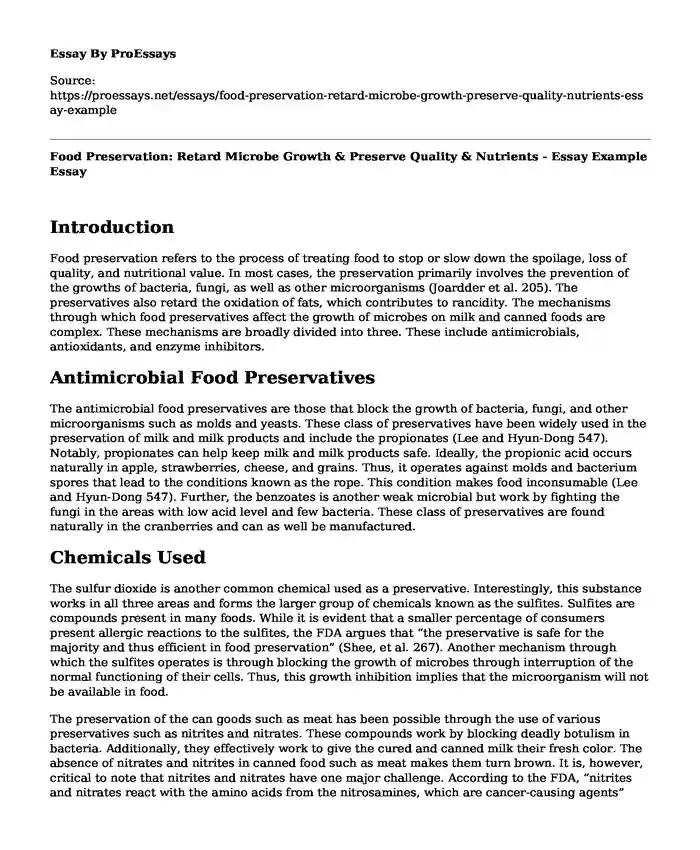Introduction
Food preservation refers to the process of treating food to stop or slow down the spoilage, loss of quality, and nutritional value. In most cases, the preservation primarily involves the prevention of the growths of bacteria, fungi, as well as other microorganisms (Joardder et al. 205). The preservatives also retard the oxidation of fats, which contributes to rancidity. The mechanisms through which food preservatives affect the growth of microbes on milk and canned foods are complex. These mechanisms are broadly divided into three. These include antimicrobials, antioxidants, and enzyme inhibitors.
Antimicrobial Food Preservatives
The antimicrobial food preservatives are those that block the growth of bacteria, fungi, and other microorganisms such as molds and yeasts. These class of preservatives have been widely used in the preservation of milk and milk products and include the propionates (Lee and Hyun-Dong 547). Notably, propionates can help keep milk and milk products safe. Ideally, the propionic acid occurs naturally in apple, strawberries, cheese, and grains. Thus, it operates against molds and bacterium spores that lead to the conditions known as the rope. This condition makes food inconsumable (Lee and Hyun-Dong 547). Further, the benzoates is another weak microbial but work by fighting the fungi in the areas with low acid level and few bacteria. These class of preservatives are found naturally in the cranberries and can as well be manufactured.
Chemicals Used
The sulfur dioxide is another common chemical used as a preservative. Interestingly, this substance works in all three areas and forms the larger group of chemicals known as the sulfites. Sulfites are compounds present in many foods. While it is evident that a smaller percentage of consumers present allergic reactions to the sulfites, the FDA argues that “the preservative is safe for the majority and thus efficient in food preservation” (Shee, et al. 267). Another mechanism through which the sulfites operates is through blocking the growth of microbes through interruption of the normal functioning of their cells. Thus, this growth inhibition implies that the microorganism will not be available in food.
The preservation of the can goods such as meat has been possible through the use of various preservatives such as nitrites and nitrates. These compounds work by blocking deadly botulism in bacteria. Additionally, they effectively work to give the cured and canned milk their fresh color. The absence of nitrates and nitrites in canned food such as meat makes them turn brown. It is, however, critical to note that nitrites and nitrates have one major challenge. According to the FDA, “nitrites and nitrates react with the amino acids from the nitrosamines, which are cancer-causing agents” (Joardder et al. 207).
Conclusion
The antioxidants constitute another class of food preservatives that help prevent microbial growth and development. Ideally, the antioxidant preservatives prevent the chemical breakdown of the food, especially when they are exposed to air. It is important to note that the unsaturated fatty acids and oils and lipids have a higher susceptibility to oxidation and will eventually take a rancid flavor and odor as a result. Studies have further shown that the antioxidants can attack the enzymes in food that causes over-ripening of various fruits and vegetables. The acids, such as the ascorbic acid (Vitamin C) and the citric acid, slow down the process through disfavoring the pH level for the enzymatic activities. Other antioxidants include the combination of sugar and alcohol for the preservation of some canned foods whereby they work by preventing chemical breakdown of products.
Works Cited
Joardder, Mohammad UH, and Mahadi Hasan Masud. "Possible solution of food preservation techniques." Food Preservation in Developing Countries: Challenges and Solutions. Springer, Cham, 2019. 199-218.
Lee, Na-Kyoung, and Hyun-Dong Paik. "Status, antimicrobial mechanism, and regulation of natural preservatives in livestock food systems." Korean journal for food science of animal resources 36.4 (2016): 547.
Shee, Anoop Kumar, et al. "Studies on the antibacterial activity potential of commonly used food preservatives." International journal of engineering science and technology 2.3 (2010): 264-269.
Cite this page
Food Preservation: Retard Microbe Growth & Preserve Quality & Nutrients - Essay Example. (2023, Oct 17). Retrieved from https://proessays.net/essays/food-preservation-retard-microbe-growth-preserve-quality-nutrients-essay-example
If you are the original author of this essay and no longer wish to have it published on the ProEssays website, please click below to request its removal:
- SCADA Protection Overlap Amongst the Corporate Groups and Governmental Agencies
- Adaptive Response: Pathophysiology of Disease Paper Example
- Research Paper on Diagnosis and Treatment of Multiple Myeloma
- Measles Outbreak: A Global Disease's Impact on Ohio - Essay Sample
- Essay on 46% of US Adults Have Hypertension: Dash Diet to the Rescue
- Essay Sample on Prompt Response to OSHA Citations & Penalties
- Report on Decoding Antibiotic-Free Labels: Standards, Definitions, and Public Health Concerns in Animal Farming







